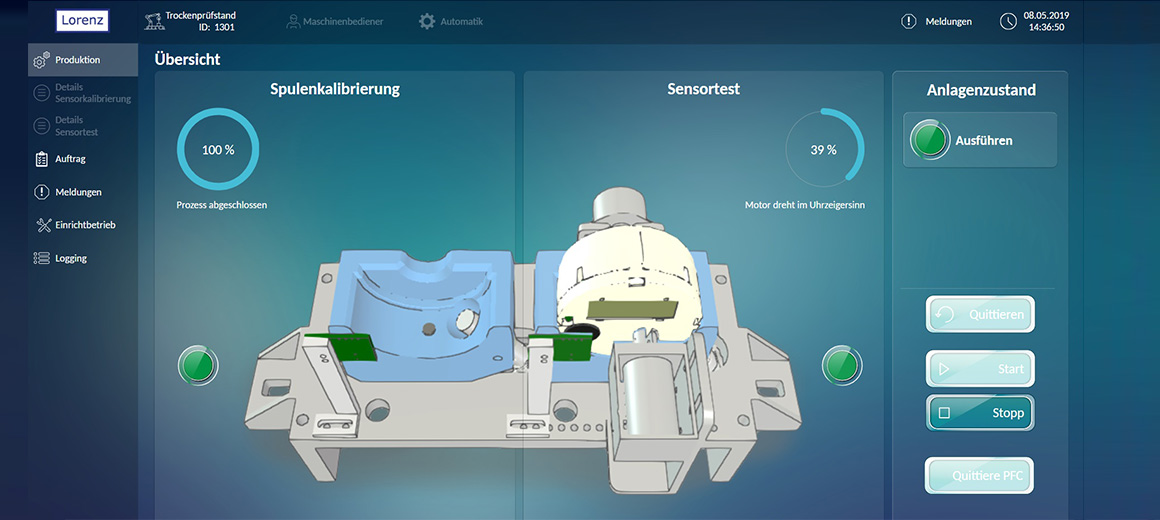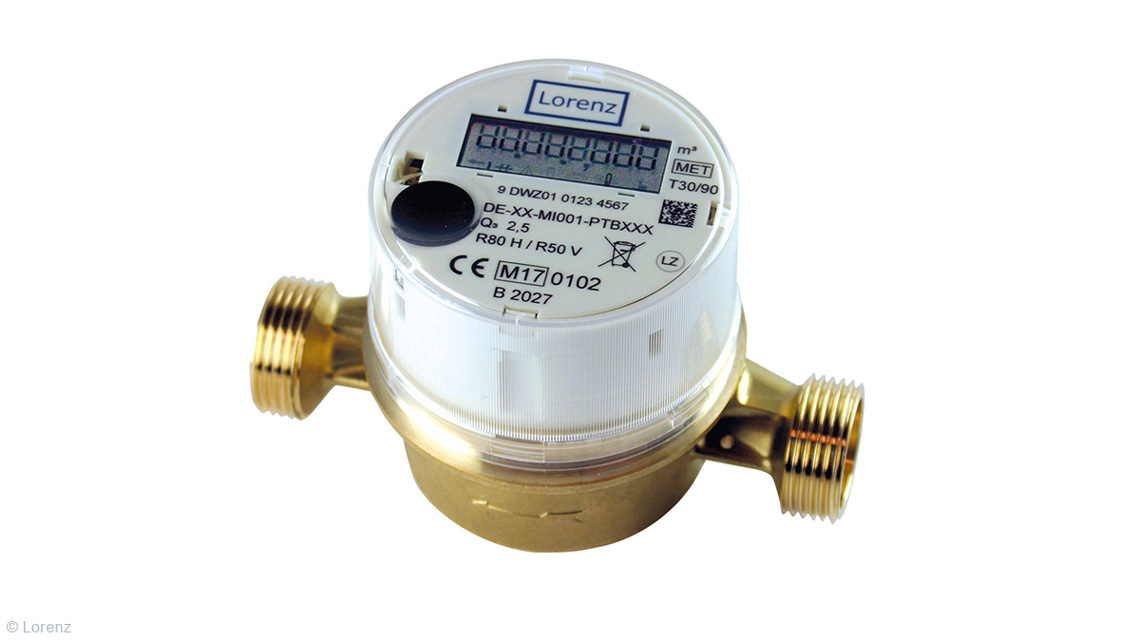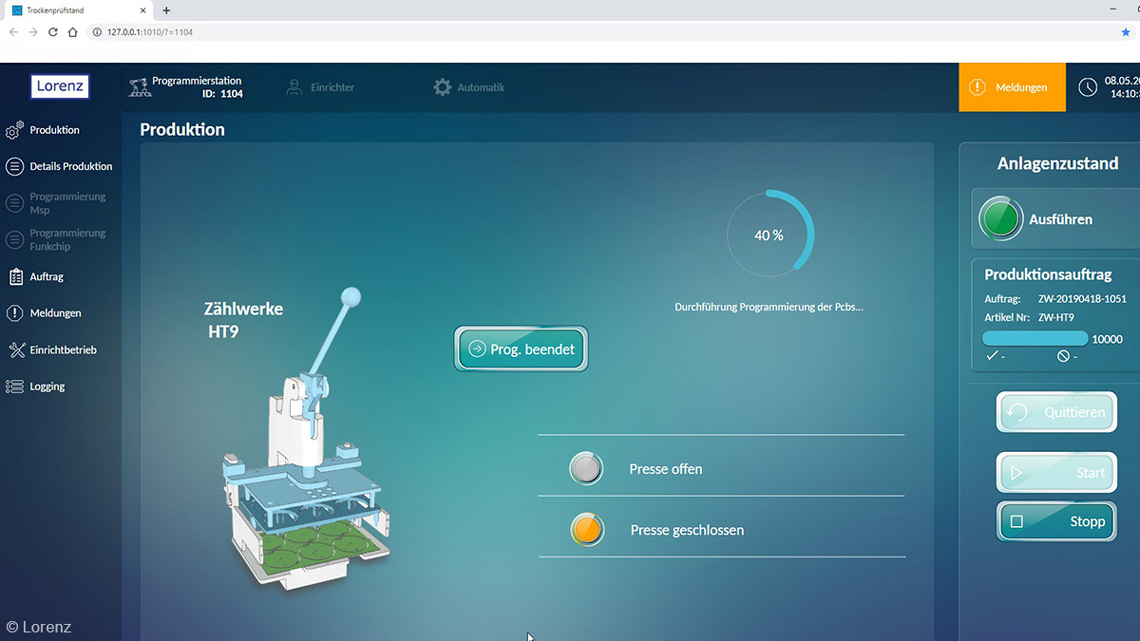

PC-based control and TwinCAT 3 as an ideal foundation for Industrie 4.0 solutions
To manufacture a new generation of radio-supported water meters, Lorenz employs an Industrie 4.0 concept with support from ITQ and Software Factory, both members of the Stetter Group. With TwinCAT 3 software and especially the new TwinCAT HMI solution, Beckhoff supplied the ideal open control and visualization technology.
Lorenz GmbH & Co. KG in Schelklingen-Ingstetten, Germany, is a specialist in flow metering and a leading manufacturer of water meters for residential units and buildings as well as commercial water meters along with related communication systems and services. The meters, which are installed in large numbers in Germany and Europe, are used mainly to operate and monitor public supply systems and to control industrial installations. Lorenz puts great emphasis on manufacturing its products in Germany, as Managing Director Wilhelm Mauß explains: “Manufacturing in Germany has been critical for our success. It allows us to make quality products with top measurement accuracy and stability, superior materials, reliable hygiene and data security. Industrie 4.0 and resource efficiency have been prerequisites for our ability to run a digitally connected and environmentally friendly operation and to provide our meters with great flexibility and the shortest lead times.”

The digitally controlled production process was installed in a 1,000 sqm production building in which water meters can be manufactured with great flexibility in lot sizes as small as one unit. It also features IoT functionalities for IT security, process data processing, traceability, visualization and intelligent apps. Since all this allows for quick and precise interventions in the control of the production lines, errors and interfering factors are reduced, and the staff can compare process sequences and find effective solutions. This way, the Ingstetten facility can produce more than 1 million water meters annually in a highly cost-efficient manner. A conventional water meter goes through more than 20 process steps ranging from the assembly of the hydraulics to programming, calibration, inspection and packaging.
Three experienced Industrie 4.0 partners
To implement the Industrie 4.0 concept, Lorenz relied on experienced partners: ITQ GmbH and Software Factory GmbH, both located in Garching, Germany, and automation specialist Beckhoff. As a service provider in the areas of software and systems engineering, ITQ has been a trailblazer in the Industrie 4.0 field for many years. ITQ received valuable support for the redesign of the Lorenz production facilities from Software Factory, which has been active in software and IT for 25 years and also acts as a systems integrator for Industrie 4.0 solutions.
ITQ developed the entire concept for Lorenz's production of digital radio water meters. In addition to consulting and development services, says Markus Lanker, senior consultant at ITQ, this included the layout, installation, commissioning, operator training, testing and simulation of the production system as well as the coordination of participating service providers and the overall project management. ITQ also helped Lorenz with the evaluation and selection of software and hardware components for the automation technology, as Markus Lanker explains: “Since the open PC-based control technology from Beckhoff provides the ideal foundation for modern Industrie 4.0 concepts, we selected the automation specialist, with whom we have worked successfully for many years, also for the water meter production as a consultant and supplier of control technology in the areas of PLC and HMI. And the very open, cooperative and committed relationship proved once again to be a huge plus. We benefited especially from their competent and informative support with regard to the new visualization, which we implemented with TwinCAT HMI (TE2000).” In terms of hardware, the water meter production uses a C6920 control cabinet Industrial PC for each line along with many EtherCAT Terminals for the I/O.

Efficient user interface engineering
The new TwinCAT HMI heralds a paradigm shift in the field of HMI software. Instead of the proprietary systems for engineering and communication requiring specific operating systems, Beckhoff banks on IT standards like Visual Studio® for the engineering, HTML5 for the design, and WebSockets and HTTPS for secure communication. The user interface can be executed on any HTML5-capable browser irrespective of the operating system, resolution or display. Beckhoff has thus created an open and future-proof Industrie 4.0 solution that optimally meets the needs of Lorenz's modern water meter production. As Reiner Beck, Lorenz’s head of production engineering, explains: “TwinCAT HMI provides an effective graphical interface for visualizing various process overviews. In addition, the HMI software is not tied to special hardware, which enables us to use standard IT components.” Production engineer Marc Gueffroy adds: “Another advantage results from the ability to broadcast the HMI at different production sites across the corporate network.”
Since TwinCAT integrates the human-machine interface directly into the engineering environment of Visual Studio®, cumbersome programming is replaced by an easy-to-use configuration process via a graphical editor. And since the resulting web-based solution is based on HTML5 and JavaScript, it operates responsively irrespective of the operating system, browser and device and can therefore run on any user device such as the Control Panels from Beckhoff, but also on tablets and smartphones. The powerful underlying architecture also makes possible a wide range of application scenarios ranging from a local panel solution to multi-client, multi-server and multi-runtime concepts. Custom-tailored enhancements are quickly implemented via defined interfaces, and the mix of standard graphical controls and custom design elements makes the process much easier.